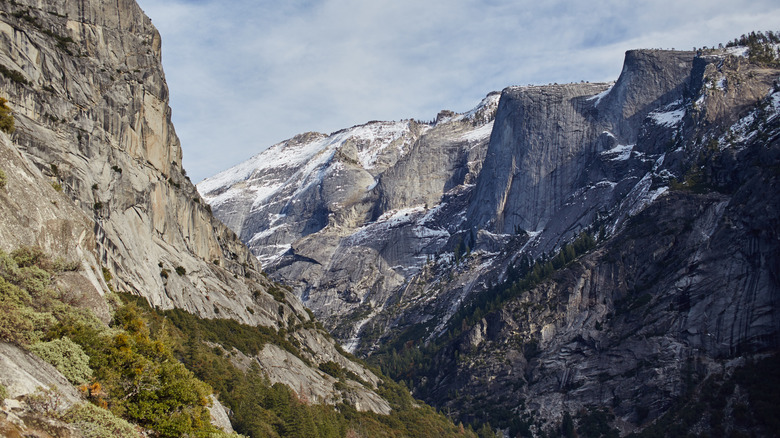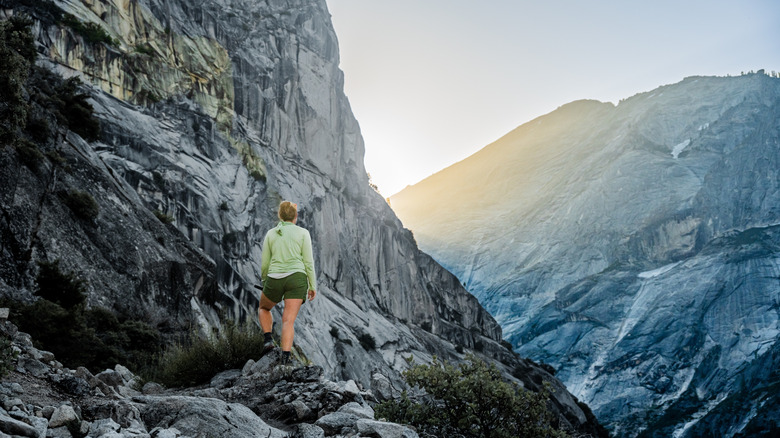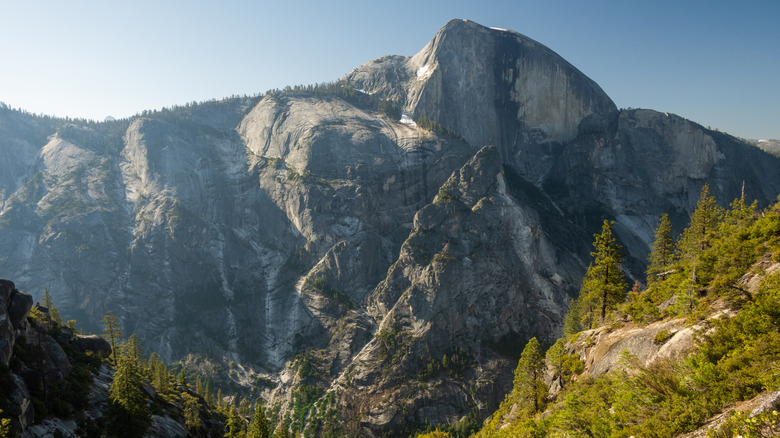One Of Yosemite's Most Notoriously Difficult Trails Is A Wild Trek Boasting Unbelievable Views Of Half Dome
Yosemite National Park is hallowed ground for adventure lovers. Folks flock here to see some of the most wonderous mountain scenery in California, to hike to the absolute best view in Yosemite from the lookouts of Taft Point, or to attempt the daring ascent of El Capitan, one of the most dangerous climbs in America and perhaps one of the most formidable climbing rocks on the planet. There are a myriad of trekking routes that weave and wind their way through the 1,169-square-mile reserve, with some of the best offering up views of the legendary Half Dome, arguably Yosemite's most shapely peak — and among them is the challenging Snow Creek Trail.
Snow Creek Trail is a path that clocks up a mega 2,700 feet of altitude gain and nearly 10 miles of distance from start to finish. It's listed as strenuous on the official NPS website, and countless reviewers on AllTrails note just how tough the going is, with one past hiker concluding that "this is NOT a hike for the faint of heart. Snow creek from mirror lake is an extrmely [sic] steep climb out of the valley. But the views were second to none. The granite wall from Clouds Rest to [Half Dome] are incredible."
It really is all about the views. As you gain height hiking up the zigzagging path on the northern side of Tenaya Canyon, a whole foray of iconic American peaks will come into view, including the 2,000-foot-high north face of the famous Half Dome, which emerges gradually with every bit of altitude you gain.
A guide to hiking the Snow Creek Trail
The Snow Creek hike begins just outside of North Pines Campground at the eastern end of Yosemite Valley. You won't get a parking spot by the path itself, so make use of the lots in Curry Village or hitch a ride on the shuttle buses, which stop right beside where the trail begins. It's easy going to start off; you begin by following the first leg of the Mirror Lake Trail through the rocky pine woods beside Tenaya Creek.
It's only once you pass Mirror Lake itself that the climb begins in earnest. The trail veers off suddenly to the north, going back and forth over and over as it clambers up a gully between Snow Creek Falls and the North Dome. Some say there are over 100 switchbacks in all, many of them totally exposed to the sun and elements. The upside is that you'll enjoy sweeping views the whole way, which get better and better until you eventually enter some woodland to find the turnaround point.
You could also opt to extend your walk into a multi-day trek, linking the Snow Creek Trail with other routes that go to the top of North Dome and the Yosemite Falls. Doing so is a much more serious undertaking that demands experience with backcountry backpacking and at least one night spent out in the wilderness.
Get stunning views of Half Dome and other peaks
The big elevation gains of the Snow Creek Trail mean you'll go high above the eastern end of Yosemite Valley. More specifically, the hike goes up the edge of Tenaya Canyon, a sub-branch of the Yosemite Valley that's flanked by some of the park's most high-profile peaks. The Half Dome, Clouds Rest, and the Quarter Domes all line up on the opposite side of the canyon to where you'll be walking, meaning you can look forward to a montage of granite mountains that all edge into frame as you conquer the switchbacks.
The Half Dome looks particularly spectacular from the top parts of the walk since it's possible to see the whole cliff face of the mountain, from its base in the valley to its very peak. What's more, the angle of the trek means you might even be able to spot people climbing the infamous Half Dome cables, where hikers latch onto steel ropes on the final ascent to the summit, completing what's surely one of the most dangerous hikes in Yosemite.
At the very start of the hike, as you walk towards Mirror Lake, and again at the end just before turning around, you'll also get to enjoy sections that pass through pine woods, between mossy boulders, and alongside gurgling creeks, not to mention the reflections of the high mountains in the lake itself. The trail is open all year round but usually gets snowy and icy during the winter, so prep accordingly.


